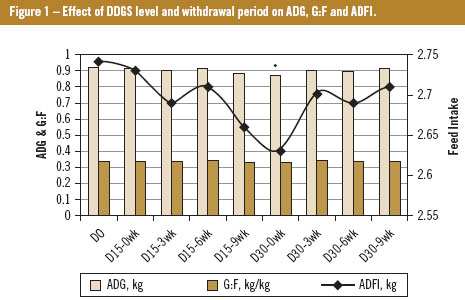Feeding strategies with DDGS to improve carcass quality

For most pork producers in North America the use of distillers dried grains with solubles (DDGS) is now common. However, research and on-farm studies have shown that while DDGS is an important ingredient, appropriate feeding strategies must be used to optimise both feed cost and carcass quality. Corn derived DDGS contains approximately 10% oil, which is rich in linoleic acid (C18:2), a polyunsaturated fatty acid that is primarily responsible for (undesired) soft pork fat.
Numerous studies have shown that when the content of DDGS is increased to 20 or 30% of the diet, pork belly firmness declines, which makes further processing more difficult and can lead to poor product quality. Recent research has demonstrated that the linoleic acid content of belly fat is significantly higher in pigs that were fed diets containing just 10% DDGS. Some US pork processors are so concerned with this issue that they have instituted a minimum iodine value (a measure of the degree of unsaturation of fat) for pork carcasses coming into their plants. Withdrawing DDGS from the diet for a period of time prior to slaughter is one alternative strategy for improving pork fat quality when feeding diets containing DDGS. Several researchers have shown that the fatty acid profile of belly fat can be manipulated by changing the diet. One such study found that when researchers changed the diet to a more saturated fat source the C18:2 content of belly fat was reduced by 60 to 70% in the first two weeks after the diet change and by more than 90% in six to eight weeks. Another positive impact of withdrawing DDGS from the diet is improved dressing percentage. Research showed that carcass dressing percentage was improved in pigs fed 30% DDGS with a three or six week withdrawal period in the grower finisher.
Field study
A comprehensive study evaluating different DDGS feeding strategies was recently completed by scientists from the University of Minnesota (2010). In this field study they looked at various DDGS feeding levels (0, 15 or 20% DDGS) and withdrawal periods (0, 3, 6, 9 weeks before slaughter) and the effects on pig growth performance, carcass quality and the fatty acid profile of pork fat. In terms of growth performance, the overall average daily gain (ADG), gain to feed (G:F) and average daily feed intake (ADFI) were not affected by dietary content of DDGS or withdrawal period (Figure 1). The growth performance of the 30% DDGS diets with no withdrawal (D30-0wk) however, was significantly different than the control diet (D0). This was inconsistent from other studies and the researchers hypothesised that it may have been due to variation in DDGS quality.
As with the growth performance data, the carcass weights and meat quality measurements taken (longissimus muscle firmness, marbling and visual colour score) were not affected by either dietary DDGS content or withdrawal period. A research review shows that the effect of increasing dietary DDGS content on carcass dressing percentage is inconsistent. Some studies showed no change in dressing percentage, while others showed a reduction in dressing percentage when increasing amounts of DDGS are fed. In this study, dressing percentage was similar for pigs fed 0, 15 or 30% DDGS and there was no effect of withdrawal period.
Iodine values
Increasing the content of DDGS in the diet increased the total polyunsaturated fatty acid content of belly fat. Linoleic acid (C18:2) content increased from 1.74 to 2.74% for diets containing 0 to 30% DDGS, respectively. As a result, pigs in the study had greater belly fat iodine values when fed increasing dietary DDGS (Figure 2). By increasing dietary DDGS withdrawal period from 0 to 9 weeks before slaughter the iodine value and C18:2 content of belly fat were significantly reduced. When compared with bellies from pigs in the control group (D0), those pigs assigned to either the 15 or 30% DDGS inclusion and nine-week withdrawal (D15-9wk, D30-9wk) achieved a similar iodine value. However, the belly fat iodine values in pigs assigned to the other dietary treatments were greater than in pigs fed the control diet. According to the US Pork Composition and Quality Assessment Procedures, created by the National Pork Producers Council (2000), acceptable pork fat quality has an iodine value of less than 70. In this study, only the 30% DDGS inclusion and zero week withdrawal treatment exceeded this value. As a result it was also the only treatment to have significantly lower belly firmness.
The results of this study and others demonstrate that while DDGS are a valuable ingredient their inclusion needs to be managed in a feeding program to avoid carcass quality issues. With any new or alternative ingredient producers should consult with their feed consultant or nutritionist to optimise feed cost and economic return.
This article was previously published in Pork News and Views of the Ontario Ministry of Agriculture and Food and Rural Affairs.











